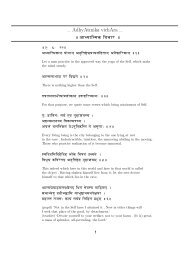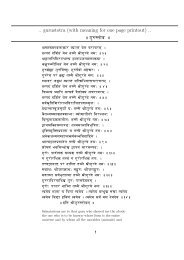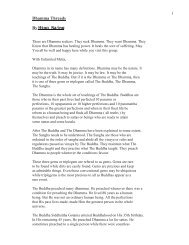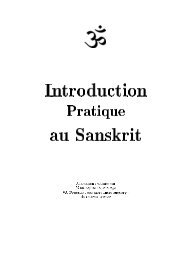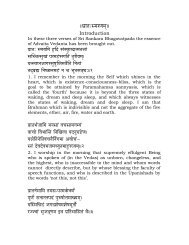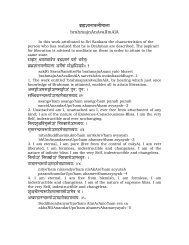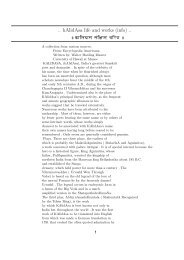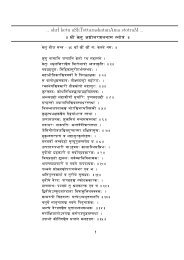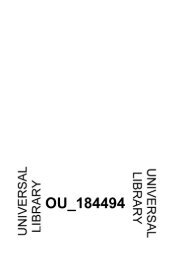Brahmasutra 1.1.4 - Sanskrit Documents
Brahmasutra 1.1.4 - Sanskrit Documents
Brahmasutra 1.1.4 - Sanskrit Documents
Create successful ePaper yourself
Turn your PDF publications into a flip-book with our unique Google optimized e-Paper software.
<strong>Brahmasutra</strong> <strong>1.1.4</strong>- iɨÉÑ xÉqÉluÉrÉÉiÉç|<br />
(Translation of the lectures of Dr. Mani Dravid Sastri)<br />
(Translation by S.N.Sastri)<br />
In this adhikarana there are two varnakas. In the first<br />
varnaka the objection of the Bhatta school of Mimamsa is<br />
refuted. In the second varnaka the objection of the Prabhakara<br />
school of Mimamsa is refuted. This is how this adhikarana has<br />
been explained by Brahmavidyabharana. Previous commentators<br />
have taken the view that, while the Bhatta view is<br />
refuted in the first varnaka, it is the view of the Vrittikara that<br />
is refuted in the second varnaka.<br />
The objection of the Bhattas is that there is no such entity<br />
as Brahman. The Vedas consist only of injunctions and<br />
prohibitions and they cannot be the pramana for any entity<br />
called Brahman. The statements in the sruti referring to<br />
Brahman are intended only as praise of the jiva.<br />
The Prabhakaras accept nirguna Brahman, but they say<br />
that direct knowledge of Brahman cannot by itself give<br />
liberation. Liberation is attained only by upaasanaa which is<br />
an action.<br />
Only by refuting these views it can be established that the<br />
Sastra is the pramana for realization of Brahman.<br />
The objection that the Vedas cannot be the pramana for<br />
Brahman is based on Jaimini sutra I.ii.1 1, which says that,<br />
since the intention of the Vedas is to enjoin action, those<br />
statements in the Vedas which do not enjoin any action do not<br />
serve that purpose. The statements in Vedanta are of this<br />
nature and so it is claimed that they do not serve the purpose<br />
of the Vedas directly. At the same time, since Vedanta is also<br />
part of the Vedas, these statements cannot be rejected<br />
outright as purposeless. They become purposeful when they<br />
are read as supplementary to injunctions, by way of eulogizing<br />
the actions enjoined by the injunctions, as stated in Jaimini<br />
sutra I.ii.7 2. A person will not perform a yajna for attaining<br />
1 AÉqlÉÉrÉxrÉ Ì¢ürÉÉjÉïiuÉÉiÉç AÉlÉjÉïYrÉÇ AiÉSjÉÉïlÉÉqÉç |<br />
2 ÌuÉÍkÉlÉÉ iuÉåMüuÉÉYrÉiuÉÉiÉç xiÉÑirÉjÉåïlÉ ÌuÉkÉÏlÉÉÇ xrÉÑÈ |
2<br />
heaven unless he knows that he has a self different from the<br />
physical body, which will go to heaven, since the physical body<br />
perishes here and cannot go to heaven. The knowledge of such<br />
a self is acquired only from Vedanta. Moreover, Vedanta<br />
instructs him also about the nature of the deities to whom he<br />
has to offer oblations and on whom he has to meditate. Thus<br />
Vedanta serves only as a supplementary to the injunctions<br />
regarding yajnas and upaasanaa, both of which are actions,<br />
upaasanaa being a mental act.<br />
Another objection is that what is already existent can be<br />
known by other pramanas also. Brahman being an existing<br />
entity, it can be known by other pramanas. If the Vedas reveal<br />
only what can be known by other pramanas, then they cease<br />
to be the sole means of knowledge of Brahman. Moreover, no<br />
purpose is served by the Vedas revealing what can be known<br />
by other pramanas. There is nothing to be accepted or rejected<br />
in respect of an existing thing and so there is no human goal<br />
to be attained by mere statements about an existing thing.<br />
The answer to these objections is that the purport of all the<br />
upanishads, as determined by applying the six indicatory<br />
signs, is Brahman. (This is dealt with in detail below).<br />
Although statements in the nature of arthavada (eulogy)<br />
become meaningful only when associated with injunctions, the<br />
same cannot be said about statements in the upanishads<br />
about Brahman because the knowledge of Brahman does<br />
culminate in liberation. Therefore Brahman is known from the<br />
upanishads alone.<br />
Vedanta cannot be supplementary to injunctions, but it is<br />
actually opposed to the performance of rituals. This is clearly<br />
evident from the statement, “Then by what and whom could<br />
one see, etc.,” (Br.up. II.iv.13) which refutes action, performer<br />
and result.<br />
Brahman cannot be known through pramanas such as<br />
perception since it has no form, quality, action, etc. It can be<br />
known only through the mahavakyas in the upanishads.<br />
Though Brahman is not something that can be accepted or<br />
rejected, that is no defect because the direct realization of
3<br />
Brahman itself destroys all sorrow along with its cause.<br />
Thereafter there is nothing more to be known.<br />
Prakatarthakara deals with another possible objection. We<br />
experience the world as real through perception. The<br />
statements of Vedanta are opposed to this experience and so<br />
they cannot be valid. The answer is that what is known<br />
through perception is not necessarily true. One example is the<br />
snake which appears as true until it is realized that there is<br />
only a rope. Here a subsequent perception nullifies the earlier<br />
one. The moon looks very small, but we know from science<br />
that it is very big. The later pramana nullifies what was known<br />
by an earlier pramana. This is known as ‘apacchedanyaya’ 3.<br />
Thus sruti nullifies what is known by perception.<br />
Prakatarthakara refers to an objection raised by one Kesava<br />
that pratyaksha pramana which is free from defect should not<br />
be rejected. The answer to this is that the objector himself<br />
considers the notion ‘I am a man’ to be an illusion though it is<br />
also supported by perception. The same argument applies to<br />
the notion ‘I am a doer, enjoyer, etc.’ which is contradicted by<br />
sruti which, being apaurusheya, is totally free from defect and<br />
is not dependent on any other pramana. The description of<br />
various devatas is no doubt for the purpose of meditation, but<br />
on that account it cannot be said that Brahman is also meant<br />
for meditation. Meditation is a mental act and it involves<br />
duality. But Brahman is only one and it can neither be<br />
accepted nor rejected. After duality has been destroyed by the<br />
knowledge of Brahman it cannot arise again. The knowledge<br />
that destroys an illusion destroys also the samskara which<br />
caused the illusion. For example, after a person has known<br />
that what is in front is only a rope, he will no longer even<br />
think of a snake as being there. So after the rise of knowledge<br />
of Brahman upaasanaa, which involves duality, is not at all<br />
possible. Though in other parts of the Veda the statements are<br />
authoritative only in association with an injunction, the<br />
knowledge of the Self itself culminates in the fruit and so the<br />
authoritativeness of the statements giving such knowledge<br />
3 AmÉcNåûSlrÉÉrÉ
4<br />
cannot be disputed. Valid knowledge (prama) is defined as that<br />
knowledge which has for its object something that is not<br />
already known and is uncontradicted (anadhigata-abaadhitaarthavishayaka-jnaanam)<br />
4. These conditions are clearly<br />
fulfilled with regard to statements about the Self and so they<br />
are authoritative. The means of knowledge called inference is<br />
not resorted to here and so there is no need to depend on an<br />
example seen elsewhere. Thus the objection that Brahman is<br />
not the purport of Vedanta is refuted.<br />
The fact that Brahman is the purport of the Upanishads is<br />
established by applying the six indicatory signs (lingas). These<br />
are: (1)the beginning and the conclusion, (2)repetition,<br />
(3)originality, (4) benefit, (5)eulogy and (6) logicality. The<br />
<strong>Sanskrit</strong> terms for these are, respectively,<br />
upakramopasamhaara, abhyaasa, apuurvataa, phala,<br />
arthavaada, upapatti. Out of these six, three relate to the<br />
subject-matter and three to the words used. In the first<br />
category fall originality, benefit, and logicality. Originality<br />
means that it should not be known by any other pramana.<br />
Benefit means that there should be some benefit to be attained<br />
by this knowledge. Logicality means that that the conclusion<br />
arrived at must stand the test of logic. These three are<br />
essential ingredients for knowing the purport. The second<br />
category consists of the other three, namely, the beginning<br />
and the conclusion, repetition, and eulogy. The conclusion<br />
should be the same as the proposition enunciated at the<br />
beginning. For example, in Pratardana adhikaranam it is said<br />
at the beginning, Pratardana asked for the most beneficent for<br />
men. At the end are the words ‘Bliss, free from aging,<br />
immortal’. Thus the beginning and the end show that the<br />
purport is Brahman. By repetition the essential teaching is<br />
emphasized, as in the repetition of the mahavakya ‘Tat tvam<br />
asi’ which is repeated nine times in Chandogya upanishad.<br />
Eulogy indicates that the subject is worth knowing. However,<br />
all these three need not be there in every case.<br />
4 AlÉÍkÉaÉiÉÉoÉÉÍkÉiÉÉjÉïÌuÉwÉrÉMü¥ÉÉlÉÇ mÉëqÉÉ |
5<br />
Thus the Bhatta view has been refuted and it has been<br />
established that the Sastra is the pramana for Brahman. The<br />
first varnaka ends here.<br />
In the second varnaka the objection of the Prabhakaras is<br />
taken up. They accept attributeless Brahman, but say that<br />
knowledge of Brahman cannot by itself remove bondage which<br />
is real. Bondage can be removed only by upaasanaa on<br />
nirguna Brahman which produces an unseen result.<br />
Sentences are of two kinds: those which enjoin some<br />
action, and those which merely describe an existing entity or<br />
fact, such “Vayu is the swiftest god”. The Prabhakaras say that<br />
sentences which merely describe what already exists are not<br />
authoritative by themselves, but become purposeful only if<br />
they are associated with another sentence enjoining an action.<br />
So sentences like ‘Brahman is truth, consciousness and<br />
infinite’ become authoritative only if they are considered as<br />
meant for describing Brahman for the purpose of upaasanaa.<br />
This is because the object of the Sastra is to instruct people to<br />
perform a certain action or to refrain from performing a<br />
particular action. So they say that Vedanta enjoins upaasanaa<br />
of nirguna Brahman. By this upaasanaa dharma (punya) is<br />
attained and this leads to liberation. Just as the Vedas<br />
describe the sacrificial post and the ahavaniya fire as a<br />
subsidiary of yajna, they describe Brahman as a subsidiary of<br />
upaasanaa which is a mental act. Those who know the<br />
purport of the Vedas say that the purport is to instruct about<br />
action. Therefore it is reasonable to hold that, just as the<br />
performance of sacrifices such as agnihotra is laid down as the<br />
means for attaining heaven, the performance of upaasanaa on<br />
Brahman is laid down as the means for attaining immortality.<br />
The answer to the above objections is that it has already<br />
been pointed out that there is a difference between what is<br />
desired in the karma kanda and in Vedanta. In the former<br />
dharma which is yet to come into being is the object desired,<br />
while in the latter the object to be known is Brahman which is<br />
always existent. The fruit of the knowledge of dharma, for<br />
attaining which action is necessary, is also different from the<br />
fruit of the knowledge of Brahman.
6<br />
The opponent says that it cannot be so, because there are<br />
instructions for meditation on Brahman such as, “The Self is<br />
verily to be seen”, “Contemplate on the Self alone”, etc. By<br />
such meditation there will ensue liberation which is an unseen<br />
result. If there is no injunction and if there are only<br />
statements of fact such as, “The earth has seven islands”, “The<br />
king is going”, etc., they will be futile, since there is nothing to<br />
be accepted or rejected.<br />
The Advaitin answers: It is seen that by the mere<br />
statement, “This is not a snake, but only a rope”, the fear<br />
generated by the illusion is removed. Similarly, here also the<br />
wrong notion that one is a transmigrating individual is<br />
removed by the statement, “You are not a transmigrating<br />
individual”, and thus the statement becomes fruitful.<br />
To this the opponent replies that it is not so, because even<br />
those who have heard Vedanta are seen to experience joy,<br />
sorrow, etc. Moreover, the sruti says that after hearing one<br />
should reflect and meditate. Therefore it follows that sruti is<br />
authoritative only as laying down the injunction of meditation<br />
on Brahman.<br />
The answer to this is: The fruit of the knowledge of dharma<br />
and the fruit of the knowledge of Brahman are quite different.<br />
Dharma is action by body, speech and mind as laid down by<br />
the sruti and smriti. Adharma is also described in order that it<br />
may be avoided. The fruit of the injunctions relating to these is<br />
happiness and sorrow which are perceptible and are<br />
experienced by the body, speech and mind through the<br />
contact of the sense-organs with objects. This is common to all<br />
living beings. There are also gradations in happiness,<br />
depending on the capacity and the effort put in by each<br />
person. Similarly there are gradations in suffering depending<br />
upon the extent of unrighteous acts performed by each<br />
person. So the sruti says that there can never be cessation of<br />
the experience of pleasure and pain as long as there is<br />
identification with the body. On the contrary, neither pleasure<br />
nor pain touches one who has given up such identification. It<br />
therefore follows that liberation, which is non-identification<br />
with the body, cannot be the result of the performance of<br />
dharma which is the content of injunctions. If non-
7<br />
identification with the body were the fruit of dharma, the<br />
denial of the experience of pleasure and pain in such a state<br />
would not be logical. Non-identification with the body is the<br />
natural state, as evident from the sruti statement, “The wise<br />
man, knowing that the self is not embodied in the body, as<br />
permanent in the transient, as great and all-pervasive, does<br />
not grieve”. Thus non-identification with the body, which is<br />
called liberation, is totally different from the fruit of dharma<br />
which involves the performance of rites laid down, and it is<br />
eternal.<br />
Upaasanaa has been described in many places in the<br />
<strong>Brahmasutra</strong>s, but it is not mentioned at all in the<br />
purvamimamsa sutras or even in the Sankarshakanda of<br />
Jaimini. So the question arises, how can it be said that<br />
upaasanaa is part of Dharmajijnaasaa? This has been<br />
answered by Chitsukha thus: Jaimini has not specifically<br />
mentioned upaasanaa because it, being a mental act, is also<br />
covered by the word ‘dharma’. Jaimini has not spoken about<br />
every rite, but only about some as examples. His object was to<br />
lay down general principles for interpreting the statements<br />
containing injunctions. These principles apply to upaasanaa<br />
also. In <strong>Brahmasutra</strong>s upaasanaas are mentioned only to<br />
state their subject and method of performance. They do not<br />
have prominence here.<br />
Some things are changefully permanent, that Is to say,<br />
though they are subject to change, the cognition “This is that”<br />
continues unaffected. Examples are the earth, etc., for those<br />
who hold the universe to be eternal, and the gunas for the<br />
Sankhyas. Brahman is, however, absolutely and immutably<br />
eternal, all-pervasive, free from all modifications, not<br />
dependent on any thing, without parts, self-luminous, not<br />
affected by dharma or adharma or their fruit, and cannot be<br />
specifically related to any of the three periods of time because<br />
of being ever existent.<br />
If liberation were to be attained through any action,<br />
including mental action, it would be impermanent. Moreover<br />
there would be gradations in the result, depending on the<br />
nature and extent of the action. But liberation is accepted by
8<br />
all to be eternal. So it does not stand to reason that Brahman<br />
is taught in the scriptures as a subsidiary to action.<br />
Many statements in the Upanishads such as, “He who<br />
knows Brahman becomes Brahman itself”, etc., show that<br />
liberation is attained simultaneously with the knowledge of<br />
Brahman and that no action is necessary in between.<br />
Liberation cannot be termed the ‘fruit’ of knowledge of<br />
Brahman, in which case it would be impermanent like any<br />
other fruit. What knowledge does is only to remove the<br />
obstacle because of which one thinks that he is in bondage. In<br />
reality every one is always free from bondage, but wrongly<br />
thinks that he is bound. The identity of the individual self and<br />
Brahman is realized when the wrong knowledge is removed.<br />
This identification of Brahman and the individual self is not<br />
meditation of the form of ‘sampat’ as in the case of the<br />
statement, ‘The mind is infinite, and the Visvedevas are<br />
infinite. Through this meditation one wins an infinite world’<br />
(Br.Up. 3.1.9). Nor is it a form of meditation called ‘adhyasa’ as<br />
in ‘The mind is Brahman’ (Ch. Up.3. 18.1). In both these cases<br />
one thing is imagined to be another by superimposition for the<br />
purpose of meditation. In sampat meditation the<br />
superimposed object is what is meditated on, while in adhyasa<br />
meditation it is the substratum that is meditated on. Thus, in<br />
the example of sampat meditation mentioned above, it is the<br />
Visvedevas who are meditated on. In the example of adhyasa<br />
meditation mentioned above, it is the mind that is meditated<br />
on. Om may be meditated on as a symbol (pratika) of<br />
Brahman, in which case the meditation would be of the<br />
adhyasa type, and the object of meditation (upaasya) is only<br />
Om. It is said in Chapter 4 of <strong>Brahmasutra</strong> that one who<br />
meditates in this manner cannot go to Brahmaloka. (It is to be<br />
noted that the word ‘adhyasa’ here has a totally different<br />
meaning from what it has in Adhyasabhashya where it stands<br />
for delusion. Here it is a deliberate act of looking upon one<br />
thing as another). Om may also be meditated on as Brahman<br />
itself, in which case it becomes a meditation of the sampat<br />
type and the object of meditation is Brahman itself.<br />
Nor is it a meditation on some special activity, as in, ‘Air is<br />
certainly the place of merger’ (Ch.Up. 4.3.1). Nor is it like a
9<br />
purification of some ingredient of a sacrifice, like the<br />
sacrificer’s wife looking at the oblation for purification. If the<br />
identity of Brahman and the individual self is considered to be<br />
only a meditation, the statements in the Upanishads such as<br />
’That thou art’, ‘I am Brahman’, etc., will be contradicted. The<br />
knowledge of Brahman is not dependent on human action<br />
(purushatantra), as in the case of meditation, but it is<br />
dependent on the thing alone (vastutantra) like the knowledge<br />
of things which are the content of valid cognitions like<br />
perception, etc. Knowledge is not a mental act like meditation.<br />
Neither such a Brahman nor knowledge of Brahman can<br />
be made subsidiary to any ritualistic action or meditation. Nor<br />
can it be said that Brahman can be the object of the act of<br />
knowing, because that would contradict the statements, “It is<br />
different from the known and also different from the unknown’<br />
(Kena. 1.4), “Through what can one know that because of<br />
which all this is known” (Br.Up. 2.4.14). There is also a<br />
specific denial of Brahman being the object of meditation. In<br />
the statement, “That which cannot be uttered by speech, but<br />
by which speech is uttered”, it is first declared that Brahman<br />
is not an object, and then it is said, “Know that alone to be<br />
Brahman and not what is meditated on” (Kena. 1.5).<br />
The question arises: If Brahman is not an object, how can<br />
it be known at all? The answer is: The scriptures seek only to<br />
remove the differences in the form of the triad of ‘knower’,<br />
‘known’, and ‘knowledge’ which are all creations of nescience<br />
and do not present Brahman as an object of knowledge. This<br />
is proved by the statements such as, “Brahman is known to<br />
him to whom it is unknown, while it is unknown to him to<br />
whom it is known. It is unknown to those who know and<br />
known to those who do not know” (Kena. 2.3), “You cannot see<br />
that which is the witness of seeing--- “(Br.up.3.4.2).Therefore<br />
liberation is only the elimination of the notion of bondage<br />
which is only imagined due to nescience, and the realization of<br />
one’s natural state. There can therefore be no question of<br />
liberation being impermanent. There would be the need for<br />
some action, mental, verbal, or physical only if liberation is<br />
something to be produced or if it is a modification of<br />
something. Being of the nature of one’s own self, it is not
10<br />
something to be attained. Even according to the view held by<br />
some other schools that the supreme Self is different from the<br />
individual self it is not something to be attained because,<br />
being all-pervasive, it is ever attained by all, like ether.<br />
Nor can liberation be the result of purification, which is<br />
either the addition of merits or the removal of defects. In the<br />
case of an inert object, knowledge has first to remove the<br />
covering of ignorance over it and make it shine, since it is not<br />
self-luminous. It could therefore be said that knowledge<br />
purifies it by making it shine. But the Self is self-luminous<br />
and does not need to be made to shine by knowledge. Since<br />
Brahman is eternally pure, there are no defects to be removed.<br />
So liberation which is of the nature of Brahman is not the<br />
result of any act of purification.<br />
If it is contended that liberation which is one’s own real<br />
nature remains covered and becomes manifest when the self is<br />
purified by some action, just as a mirror manifests its lustre<br />
when it is cleaned of dust by rubbing, the answer is, it is not<br />
so, because the self cannot be the locus of any act. Any action<br />
brings about a change in the locus of the action. If the self<br />
changes because of some action it would be impermanent and<br />
statements such as ‘It is described as immutable’ (Gita, 2.25)<br />
would be contradicted. Therefore no action is possible on the<br />
self. When it is said that the embodied soul is purified by bath,<br />
achamana, investiture with the sacred thread, etc., it is not<br />
the pure self that is purified but the self associated with the<br />
body, mind, etc, which is considered to be the self due to<br />
ignorance. When a person who is ill takes medicine it is the<br />
body that is cured of the disease and not the self which is not<br />
subject to any disease. All actions are performed and the<br />
results enjoyed by a person who has the notion ‘I am a doer’<br />
because of identification with the body, mind, etc. Liberation is<br />
identity with Brahman and it is not some thing to be attained<br />
though any purification.<br />
Knowledge is not a mental act. A mental act such as<br />
meditation is based on an injunction which is independent of<br />
the nature of the thing concerned. Meditation is a mental act,<br />
because it depends on the will of the person performing it, as<br />
for example in such sentences as “When the priest (called
11<br />
Hota) is about to utter ‘vashat’, he should meditate mentally<br />
on the deity for whom the libation is taken up (by the<br />
Adhvaryu)”. This is certainly a mental act, since it arises from<br />
an injunction alone. But knowledge arises from valid means<br />
such as perception, inference, etc and the valid means cognize<br />
things as they are. For example, to think of a man or woman<br />
as fire, as enjoined in “ O Gautama, man is surely fire”<br />
(Ch.up.5.7.1) , or in “O Gautama, woman is surely fire”<br />
(Ch.up.5.8.1) is certainly a mental act, since it arises from an<br />
injunction alone. But the cognition of fire with regard to the<br />
well-known fire is not dependent on any injunction or on the<br />
will of any man. Meditation is therefore described as purushatantra<br />
(dependent on the person), while knowledge is called<br />
vastu-tantra (dependent on the object to be known).<br />
Thus the realization of the identity of Brahman and the<br />
individual self is knowledge and it is not dependent on any<br />
injunction. Though verbs in the imperative mood are found to<br />
be used, they become ineffective like the sharpness of a knife<br />
when used against a stone. They are aimed at something<br />
beyond the range of human effort, since Brahman, which is<br />
the object of the knowledge, can neither be accepted nor<br />
rejected. These statements which appear to be in the<br />
imperative mood are meant to turn the mind away from the<br />
natural tendency towards external objects by pointing out that<br />
Brahman is worthy of being realized. The ordinary person<br />
engages in activity with the object of attaining happiness and<br />
avoiding sorrow, but he does not thereby attain the ultimate<br />
goal of life. Passages such as “The Self is verily to be realized”<br />
turn him away from natural activity and towards his inner<br />
self.<br />
The fact that the self is not something that can be either<br />
accepted or rejected is, far from being a defect, an ornament.<br />
When Brahman is realized as one’s own self there is nothing<br />
more to be accomplished.<br />
The contention of some persons that there is no portion of<br />
the Veda which merely makes a statement about something<br />
and does not contain an injunction or a prohibition is not<br />
valid, because the self spoken of in the upanishads is not<br />
subordinate to anything else. It cannot be said that Brahman
12<br />
presented in the upanishads, which has no transmigration,<br />
which is distinct from the four kinds of products of action,<br />
which occurs in a section of the Vedas exclusively devoted to<br />
it, and which is not subsidiary to anything else does not exist<br />
or is not known, because it is the very self of even the person<br />
who denies it.<br />
Now an objection is raised that, since the self is the content<br />
of the concept ‘I’ it cannot be said that the self is known only<br />
from the upanishads. This has been refuted by pointing out<br />
that the self is the witness of even the concept ‘I’. The pure self<br />
which is different from the ego which is the agent, is the<br />
witness of the concept ‘I’; it dwells in all creatures, it is the<br />
same in all, it is only one, it is immutably eternal, and it is not<br />
known in the section of the Vedas dealing with injunctions or<br />
in the works of logicians. So this self cannot be denied by any<br />
one, nor can it be subsidiary to any injunction. Being the self<br />
of all, it is beyond rejection and acceptance. All modifications<br />
are perishable. The self alone is imperishable because there is<br />
no cause for its destruction. It is by nature eternal, ever pure,<br />
consciousness itself, and ever free from bondage. The texts,<br />
”There is nothing higher than Purusha; He is the culmination,<br />
He is the highest goal” (Katha, 1.3.11), and “I ask about that<br />
self spoken of in the upanishads” (Br. Up. 3.9.26), establish<br />
that the self is what is principally revealed in the upanishads.<br />
Therefore the claim that there is no section of the Vedas which<br />
deals with an existent entity is mere bravado.<br />
As regards the quotation from those who know the purport of<br />
the scriptures, “Its purport is indeed seen to be the teaching of<br />
rituals”, etc., that has to be understood to refer to the<br />
teachings about injunctions and prohibitions, since the<br />
subject there is enquiry into dharma.<br />
Now an objection of the Prabhakara school of<br />
purvamimamsa is taken up and answered. They say that,<br />
since the purpose of the Vedas is to enjoin action, statements<br />
that do not have that purport are purposeless. The answer is<br />
that this cannot apply to statements about Brahman which is<br />
eternal. The knowledge of Brahman results in the eradication<br />
of nescience which is not real and which is the cause of<br />
transmigratory existence. Moreover, if it is said that sentences
13<br />
which do not contain an injunction are purposeless, then<br />
sentences containing prohibitions, such as “A Brahmana<br />
should not be killed” will also become purposeless, which is<br />
clearly not acceptable to any one. The statements about<br />
Brahman are not of the same nature as the arthavadas in the<br />
karma kanda which have to be associated with an injunction<br />
to become meaningful. Even mere affirmative statements are<br />
found to be effective in achieving a useful result. For example,<br />
the statement, “This is a rope and not a snake” removes the<br />
fear caused by the wrong perception of a rope as a snake. It<br />
cannot by any means be said that even after one has realized<br />
Brahman he continues to live a worldly life as before. For one<br />
who has realized the identity of the individual self and<br />
Brahman life cannot continue as before. The upanishad says,<br />
“Ideas of something being pleasant and something unpleasant<br />
do not at all arise for one who has become un-embodied”<br />
(Ch.up. 8.12.1). Being embodied means being identified with<br />
the body. Identification with the body is the result of<br />
nescience. Once nescience has been destroyed, there cannot<br />
be any identification with the body and therefore there can be<br />
no fear, sorrow, etc. The self is eternally un-embodied.<br />
If it be said that being embodied is caused by the merit<br />
and demerit acquired by the self by the performance of various<br />
kinds of action, both good and bad, the answer is, it is not so.<br />
All actions are performed by the body. The self does not<br />
perform any action. A king is said to have won a battle<br />
because of his mere presence even though it is only his<br />
soldiers who have fought and won, because a relationship of<br />
master and servant has been brought about through the<br />
payment of salary by the king to the soldiers. But that analogy<br />
cannot apply here because there is no such relationship<br />
between the self and the body. The self is considered as an<br />
agent and enjoyer only because of wrong identification with<br />
the body due to nescience.<br />
Nor can the conceit of ‘I’ in the body be said to be only<br />
secondary, as in the case of referring to a student as a lion.<br />
Here the difference between the student and a lion is well<br />
known, but the student is referred to as a lion only because he<br />
is considered to possess some qualities of a lion such as
14<br />
courage. When a post is mistaken for a man in mild darkness,<br />
or when a shell is mistaken for silver, it is a case of illusion. In<br />
the same way, the concept of ‘I’ with respect to the body, etc.,<br />
because of non-discrimination between the self and the notself<br />
is a case of illusion. Even those who have knowledge of the<br />
difference between the self and the not-self fail to discriminate<br />
between the two in actual practice. Hence ‘being embodied’<br />
(sariratvam) is caused by nescience. For the enlightened<br />
person, even when he is alive, there is non-embodiment<br />
(asariratvam). About the enlightened person it is said, “Just as<br />
the lifeless slough of a snake is cast off and it lies in the anthill,<br />
so does this body lie. Then the self becomes disembodied<br />
and immortal, becomes Brahman, the self-effulgent Light”<br />
(Br.up. 4.4.7). There is also the statement, “Though without<br />
eyes, he appears as if possessed of eyes; though without ears,<br />
he appears as if possessed of ears; though without speech, he<br />
appears as if possessed of speech, though without mind, he<br />
appears as if possessed of mind; though without vital force he<br />
appears as if possessed of vital force”. The Gita also says that<br />
in the case of an enlightened person there is total absence of<br />
any connection with any impulsion to work (Gita, ch.2).<br />
Therefore a person who has realized his identity with Brahman<br />
cannot continue in the worldly state as before. If a person<br />
continues in his worldly state as before, it means that he has<br />
not realized his identity with Brahman.<br />
The contention that, since reflection and meditation are<br />
mentioned after hearing, Brahman must be considered to be<br />
supplementary to an injunction is not tenable. Reflection and<br />
meditation are also the means to realization. If Brahman had<br />
been known through some other source of knowledge and then<br />
used in some other act or meditation, then it could have<br />
become subsidiary to an injunction, but that is not the case.<br />
Just like hearing, reflection and meditation are also meant for<br />
attaining realization of identity with Brahman. It there follows<br />
that Brahman is presented as an independent entity; for, on a<br />
harmonious interpretation of the upanishadic texts, it is seen<br />
that their purport is Brahman only. Hence the commencement<br />
of a separate scriptural text about Brahman is fully justified.<br />
The fact that the subject, competent person and benefit
15<br />
relating to this topic are different from those for the enquiry<br />
into dharma and these have been brought out here, further<br />
establishes this point. Once Brahman is realized, there can be<br />
no possibility of the persistence of the means of knowledge<br />
which become devoid of their objects and subjects. Then the<br />
secondary and false selves, such as body, son, etc., cease to<br />
exist and there can be no action prompted by injunction or<br />
prohibition. The empirical means of knowledge cease to be<br />
valid on realization of Brahman.<br />
****************




